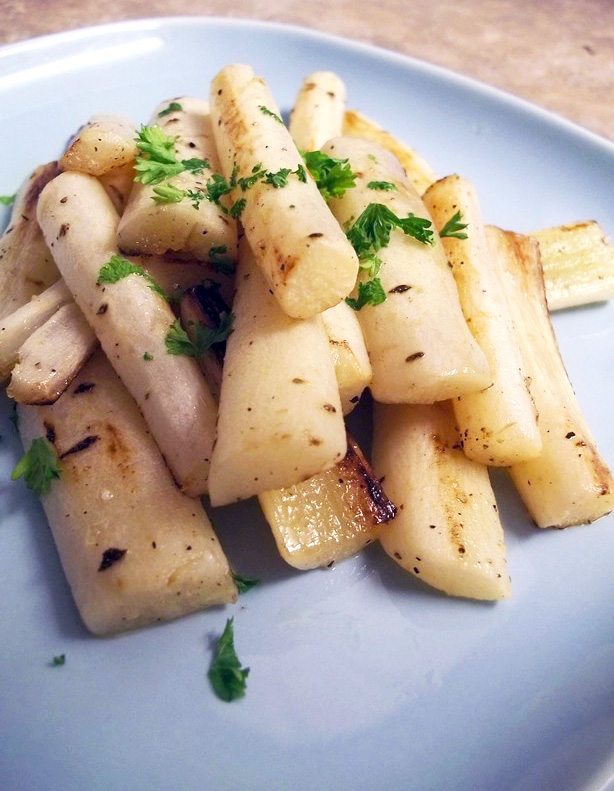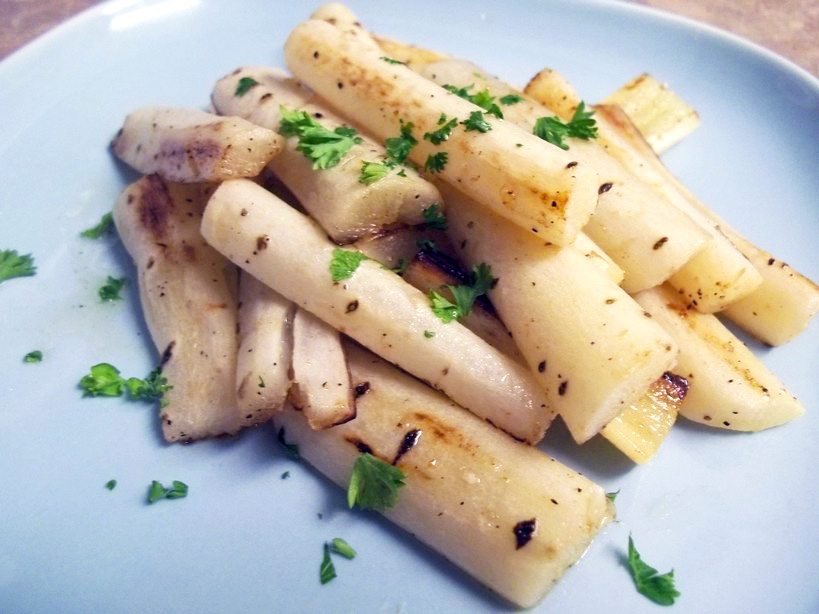Thanks for all your good wishes. I am still fighting this cold. Some days I win, some days the cold winds. But it shall pass. Thus I remain a bit quieter still on the blog front.
OK so raise your hands if you have ever tried salsify before? I knew it, only 2 of you know what this root vegetable is, right? The first I ever heard about salsify was the day my mom mentioned them from her childhood and she said they sorta vanished. Of course I made it my mission to buy some if I ever came across a bunch of salsify. And guess what? That day has come. I purchased them on the same occasion that I bought the topinambour (or Jerusalem Artichoke) . And I am keeping the mystery for a third exotic vegetable discovery that day, to be posted soon.
I bet I know what you are thinking: you want me to eat that UGLY thing? Yes I do and trust me you will love it. There are two types of salsify actually: the white salfify and the black salsify. I think you guessed I got the black one. It can also be called black oyster plant, serpent root, viper’s herb, viper’s grass. The black salsify is native to Southern Europe and the Near East. Although the skin is black the inside flesh is a creamy white.
There are a few precautions to know before preparing black salsify. The thick black skin exudes a sticky latex substance when peeled before cooking. Some prefer to boil the salsify first and peel once cooled. And once the salsify is peeled you want to immerse it immediately in water with lemon juice added or the flesh will turn brown very rapidly.
It’s mystical witchy look of course made people think it was miracle cure against the bubonic plague and snake bites. I am sad to say those claims are both false but it is a wonderfully nutritious root vegetable. It contains potassium, calcium, phosphorus, iron, sodium, and vitamins A, B1, E and C.
The salsify taste is reminiscent of artichoke hearts or a delicate asparagus. Some even say it has a faint taste of oysters but I did not think this to be true. I found a wonderful and simple recipe using the pan roasting method on the Eggs on Sunday blog. Basically you boil the salsify first to cook the vegetable and then you roast in a pan with caramelizes a little bit the exterior and intensifies the flavor.

Pan-Roasted Salsify
Ingredients
- 4 large or 8 thin/small salsify roots
- Juice from 1 lemon
- 1 teaspoon black peppercorns
- 1 bay leaf
- 1 –2 tablespoons extra-virgin olive oil
- Kosher salt and freshly ground black pepper to taste
- A sprinkling of chopped parsley or thyme
Instructions
- Peel the salsify roots and place them in a shallow pan with water to cover, lemon juice, black pepper, bay leaf, and salt to taste. Bring to a simmer and cook until tender (about 20-30 minutes, simmering, based on the thickness of the roots.)
- Remove the salsify roots from the liquid and let cool slightly, then cut into small pieces (I cut mine into 2-inch batons.)
- Heat some olive oil in a saute pan over medium heat until hot, then add the salsify pieces along with a sprinkle of coarse salt and a grinding or two of fresh black pepper. Cook until golden brown, then toss in the chopped fresh thyme at the end.








Was looking through seed catalogs and found salsify, wasn’t sure what it was so did a search and found your post-salsify will be in my garden this year. Thanks!!!!
I looove salsify. Actually most of the strange roots appeal to me. Can you do a burdock recipe soon?
How interesting – I love learning about new veggies. I’ve never seen salsify before anywhere, but I’m sure I’d like it!
What a great way to cook salsify! Love it and they do look weird, but the taste is so good!
I can’t say that I’ve ever tried this but looks definitely like something I would enjoy …hope you are 100% soooon! =)
I’ve heard of this veggie, but never seen it! It’s not going to win any beauty contest, but if it tastes anything like artichokes,I’ll be a fan!
Glad this is so new for just about everyone. cakewhiz totally would be a perfect side dish for chicken. Lisa the salsify taste is reminiscent of artichoke hearts or a delicate asparagus. Some even say it has a faint taste of oysters but I did not think this to be true.
Never had it before. It looks interesting though.
I have never had salsify before so my hand is down. It looks interesting and I’ve always wanted to try it. I love that you’re so adventurous when it comes to unique and rare foods. My question is..what does it taste similar to, or how would you describe the taste? 🙂
that’s a new vegetable for me but it does look interesting. sorta like a narrow potato…heheh. i think it would make a nice side dish to a baked or grilled chicken maybe? what do you think?
Yes, you really got me puzzled, never heard or seen salsify…and must admit that it look kind of weird….but will take your words and if happen to see, I will definitely try it.
Have a great week Evelyne and thanks for introducing me to something new.
Salsify is a new ingredient….I would love to try it! I love root vegetables!
o yes, I love black salsify. They are so delicious!
I’ve eaten it but I can’t say that I’ve ever cooked salsify! Now you’ve got me on a mission to find some and cook it! 😀